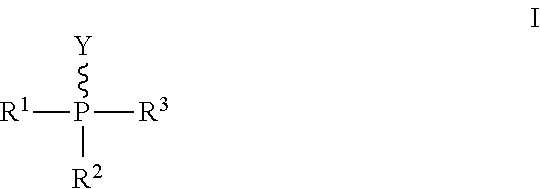Binder compositions with polyvalent phosphorus crosslinking agents
a crosslinking agent and binding composition technology, applied in the field of fibrous insulation and nonwoven mats, can solve the problems of general inapplicability of phosphinic acid and its salts and esters, and achieve the effects of saving time and money, being convenient to use, and being convenient to us
- Summary
- Abstract
- Description
- Claims
- Application Information
AI Technical Summary
Benefits of technology
Problems solved by technology
Method used
Image
Examples
examples
[0084]Example 1-14 are incorporated from U.S. patent application Ser. No. 12 / 900,540, filed Oct. 8, 2010, incorporated herein.
examples 15-16
Binder Preparations with Citric Acid Crosslinkers
[0085]The binder compositions set forth in Table 4 were prepared according to the following general procedure. Crosslinking agents were dissolved or dispersed in water to form a dispersion. The polyol was then mixed into the dispersion to form the binder composition. In some formulations, a cure accelerator (i.e., catalyst) was added, as well as other additives as set forth in Table 4. The binder composition is further diluted with water to obtain a desired amount of solids. The pH was measured and given in Table 4.
TABLE 4Binder recipes (weight in percent, except total weight in grams)Example 15Component(Control)Example 16Maltodextrin6.525.51(as polyol)CrosslinkerCitric AcidCitric Acid1.631.6385% Phosphoric Acid1.10Catalyst0.640.39(50% SHP)gamma-aminopropyl-1.291.45trihydroxy-silane (2%solution)Water89.9289.72Total (g)800800pH observed1.91.57
examples 17-20
Binder Preparations with Phosphorus Crosslinkers
[0086]The binder compositions set forth in Table 5 were prepared according to the general procedure of Examples 15-16. The pH was measured and given in table 5.
TABLE 5Binder recipes (weight in percent, except total weight in grams)ExampleComponentExample 17Example 18Example 1920Maltodextrin6.445.6811.966.44(as polyol)Diammonium2.032.802.992.03Phosphate(as crosslinker)28% Ammonium0.06hydroxide(pH adjuster)gamma-1.271.272.241.27aminopropyl-trihydroxy-silane(2% solution)Water90.2590.2582.890.2Total (g)800800800800pH observed2.42.3638.4210
PUM
| Property | Measurement | Unit |
|---|---|---|
| density | aaaaa | aaaaa |
| density | aaaaa | aaaaa |
| density | aaaaa | aaaaa |
Abstract
Description
Claims
Application Information
 Login to View More
Login to View More - R&D
- Intellectual Property
- Life Sciences
- Materials
- Tech Scout
- Unparalleled Data Quality
- Higher Quality Content
- 60% Fewer Hallucinations
Browse by: Latest US Patents, China's latest patents, Technical Efficacy Thesaurus, Application Domain, Technology Topic, Popular Technical Reports.
© 2025 PatSnap. All rights reserved.Legal|Privacy policy|Modern Slavery Act Transparency Statement|Sitemap|About US| Contact US: help@patsnap.com



